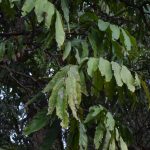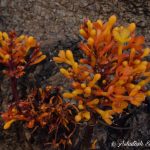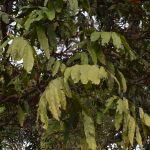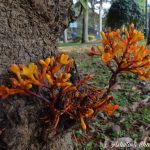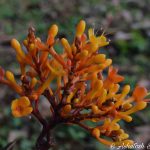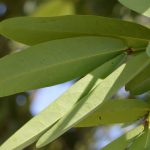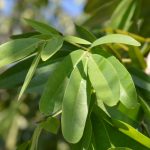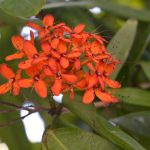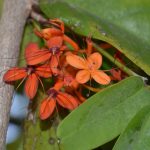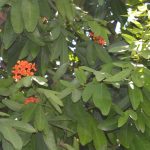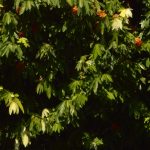|
Saraca indica L. (syn: Jonesia asoca sensu auct. (misapplied name); Jonesia confusa Hassk. (ambiguous synonym); Jonesia minor Zoll. & Moritzi; Jonesia pinnata Willd. (ambiguous synonym); Saraca arborescens Burm.f.; Saraca asoca sensu auct. (misapplied name); Saraca bijuga Prain; Saraca confusa (Hassk.) Backer (ambiguous synonym); Saraca harmandiana Pierre; Saraca indica var. bijuga (Prain) Gagnep.; Saraca indica var. zollingeriana (Miq.) Gagnep.; Saraca kunstleri Prain; Saraca lobbiana Baker; Saraca minor (Zoll. & Moritzi) Miq.; Saraca minor var. bijuga Prain; Saraca pierreana Craib; Saraca zollingeriana sensu Prain, non Miq. (misapplied name));
.
Andaman Is (I) ; Bangladesh (I); India (I) ; West Bengal; Indonesia (N) ; Jawa (N) ; Laos (N) ; Malaysia (N); Myanmar (N); Peninsular Malaysia (N); Singapore (N); Sri Lanka (I) ; Sumatera (N) ; Seychelles (I); Thailand (N) ; Vietnam (N); Egypt (I); South Africa (I); Tanzania (I); Uganda (I) as per ILDIS;
.
Saraca indica as per Flora Malesiana (Flowering collections of Saraca indica can be recognized by the rather higher number of stamens (usually 6-8) and the bracteoles which are erecto-patent to spreading, not clasping the pedicel, and caducous or persistent during anthesis.) with differences as per illustration at Link.
.
As per efi thread:
Filaments are puberulous in Saraca indica (glabrous in Saraca asoca).
.
Here’s a new addition to our website.
Saraca declinata (Jack) Miq.
Common Name – Red Saraca, Thai Ashok
Family – Fabaceae
Photographed in cultivation at Lalbagh Botanical Garden, Bengaluru, Karnataka In February 2022 How is it different from images at Saraca thaipingensis ? I had similar thoughts.
Since I have covered Lalbagh Gardens a number of times during my visits to Bangalore.
As also … I think appears to be S.indica as per You can also check the ovary character, if possible as per keys (from the high res. images) from above at
The key was prepared based on the percent of correlation of marker characters of studied species and which also follow the traditional method of key construction. The key is given below.
Sorry for delayed response as i was earlier busy with field work. After detailed analysis and comparing with available keys and images i am also of the view it is Saraca indica L., thanks for your keen observation and thus correcting identity. It was actually misidentified and labelled as S. declinata at Lalbagh BG which i blindly trusted.
I am attaching here some more images showing a comparison collage with S. thaipingensis and S. indica bracteole which is one of the easy key characteristic to distinguish between the three species i.e. S. indica, S. declinata and S. thaipingensis.
Also find attached a paper showing detailed differences between these three species. . SK 2383 13 January 2020 : 12 posts by 4 authors. 6 very high res. images Location: Bangkok, Thailand
Date: 07 December 2019
Elevation: MSL
Habitat: Cultivated
Which Saraca? asoca or indica??
Saraca asoca (Roxb.) Willd. synonym … Saraca indica “sensu Bedd., non L.” Saraca indica L. is an accepted species and not synonymous with former. Saraca asoca sensu auct. is misapplied as synonym.
I am not familiar with this tree and leaf looks different from what I have seen on facebook in name of Saraca asoca.
Thailand (and SE Asia) is native for S. indica L. as well as S. declinata and S. dives. Peninsular India is native for S. asoca. Thank you …! I feel it could be S. indica L..
Does not appear to be Saraca asoca (Roxb.) Willd. as per details and images herein, as suggested by …
Pl. check Saraca indica per Flora Malesiana (Flowering collections of Saraca indica can be recognized by the rather higher number of stamens (usually 6-8) and the bracteoles which are erecto-patent to spreading, not clasping the pedicel, and caducous or persistent during anthesis.) with differences as per illustration at Link. I can not check the differences as pointed out in the illustration. Descriptions are given below:
Saraca indica
Tree to 24 m tall and 34 cm in diam. Leaves (l-)2-4(-7)-jugate, subsessile to shortly petioled; petiole and rachis (0.5-)7-25(-35) cm long. Inflorescences up to 10(-22) cm wide, slightly pubescent or subglabrous, main branches up to c. 14 cm long, 1.5-5 mm diam.; bracts elliptic or ovate-oblong, 3-8 by 1.5-4.5 mm, caducous or persistent, puberulous and/or minutely ciliate on the margin; bracteoles caducous or persistent during anthesis, erecto-patent to spreading, broadly elliptic or ovate, 3-8 by 1.5-5 mm, glabrous or minutely ciliate on the margin; pedicels (4-) 12-20(-35) mm, the length between bracteoles and flower 7-10(-14) mm. Flowers orange yellow, to deep orange or purple, or red, articulated near the base, glabrous. Stamens (5 or) 6-8(-10); filaments 10-35 mm, often puberulous at the basal parts; anthers ellipsoid or oblong, c. 1 mm long; staminodes absent. Seeds ovoid-oblong, sometimes reniform, 4-5 by 2-2.5 cm, and 0.6-1.2 cm thick.
Asia-Tropical:, Jawa (Jawa ‒ present); Laos (Laos ‒ present); Malaya (Peninsular Malaysia ‒ present); Sumatera (Sumatera ‒ present); Thailand (Thailand ‒ present) S Vietnam: present
Thailand, Laos, S Vietnam; Malesia: Sumatra, Malay Peninsula, Java
Commonly cultivated as an ornamental
Saraca asoca
Tree up to 10 m tall and 10 cm in diam., sometimes shrub or medium-sized shrub, 4.5 m tall. Leaves (l-)4-6-jugate, subsessile to shortly petioled; (petiole and) rachis (0.5-)7-15(-30) cm long. Inflorescences 1.5-12(-20) cm wide, glabrous, main branches up to c. 6 cm long, 1.5-2 mm diam.; bracts broadly ovate, ovate or obovate, 1-6 by 1 — 3.5( — 5) mm, caducous or persistent, puberulous and/or minutely ciliate on the margin; bracteoles persistent during anthesis, erect, embracing the pedicel, never spreading more than 45° from the pedicel, ovate, elliptic, or obovate, 2-7 by 1.5-4 mm, sparsely puberulous, subglabrous or glabrous except minutely ciliate on the margin; pedicels 8-18 mm, the length between bracteoles and flower (4-)7-10 mm. Flowers obscurely or not articulated near the base, subglabrous or glabrous, orange yellow, when older deep orange or orange red, fragrant during the night. Stamens (5 — )6 — 8( — 10); filaments (10-) 17-25 mm, glabrous; anthers ellipsoid or oblong, 1.5-2 mm long; staminodes 0-2. Seeds oblong-ellipsoid, sometimes slightly reniform, 2-3 by 1.25-2 cm, and 0.6-1 cm thick.
Asia-Tropical:, Bangladesh (Bangladesh ‒ present); India ‒ present; Jawa (Jawa ‒ present); Malaya (Peninsular Malaysia ‒ present); Sri Lanka (Sri Lanka ‒ present); Sumatera (Sumatera ‒ present) Papua New Guinea: present west of the Irrawaddy R.: present
India, Sri Lanka, Bangladesh and Burma (west of the Irrawaddy R.). Introduced and cultivated in Malesia, specimens seen from Sumatra, Malay Peninsula, Java, Papua New Guinea.
The species is frequently planted near shrines, occasionally in gardens and villages as an ornamental. Its bark, leaves and flowers said to have medicinal properties .
Saraca declinata is mentioned in Flora Malesiana, but possibly not cultivated.
I can observe filaments are puberulous as mentioned in Saraca indica (glabrous in Saraca asoca). So possibly it can be Saraca indica Confusion seems to be prevalent in GBIF also as also in other sources on net. . The fact that Flora of British India described the sacred Ashok tree under the name Saraca indica L., and Jonesia asoka Roxb. as its synonym, has often led many to believe that perhaps Saraca asoka and Saraca indica are the same tree and synonyms, the fact is not exactly so.
As it appears the Sacred Indian Ashok tree was decribed by Roxburgh under the name Jonesia asoka, but the name got ignored because earlier Beddome (1870) in Fl. Sylv. and later Baker in FBI (1878) thought this to be same as Saraca indica L., described by Linnaeus, and the name Saraca indica L. continued to be used from this important sacred tree.
It was De Wilde in 1967 who established that Indian plant is distinct from Saraca indica L., and made a new combination Saraca asoka (Roxb.) De Wilde, based on Jonesia asoka Roxb., and that is now the accepted name for our tree, quite distinct and not synonymous with Saraca indica L.
Whereas Saraca asoka (Roxb.) De Wilde is native of South India, Bangladesh and Western Myanmar, it has been introduced in other parts of India and other countries of SE Asia and Tropical Africa.
Saraca indica L., on the other hand is native of Laos, Thailand; Vietnam, Indonesia, Java, Sumatra and Malaysia. but is reported (Flora Ceylone) to be introduced into India (along with Saraca declinata (Jacq.) Miq. and Saraca thaipingensis Cantley ex Prain). Perhaps it would be interesting to
1. know the difference bewtween Saraca asoka (Roxb.) De Wilde and Saraca indica L.
2. Locate, photograph and upload real Saraca indica L.
Also if any one is lucky to find other two species, also introduced in India.
Who knows it may be among some of our photographs.
Many thanks for this enlightenment, … For that some one has to dig out the differences between Saraca asoca Saraca indica L.
I have not been able to find yet. Thanks … for explaining the difference among the species. I think In Bangalore SGK Nursery will be having all these vars of Saraca. Pl. check Saraca indica as per Flora Malesiana (Flowering collections of Saraca indica can be recognized by the rather higher number of stamens (usually 6-8) and the bracteoles which are erecto-patent to spreading, not clasping the pedicel, and caducous or persistent during anthesis.) with differences as per illustration at Link. Descriptions are given below:
Saraca indica
Tree to 24 m tall and 34 cm in diam. Leaves (l-)2-4(-7)-jugate, subsessile to shortly petioled; petiole and rachis (0.5-)7-25(-35) cm long. Inflorescences up to 10(-22) cm wide, slightly pubescent or subglabrous, main branches up to c. 14 cm long, 1.5-5 mm diam.; bracts elliptic or ovate-oblong, 3-8 by 1.5-4.5 mm, caducous or persistent, puberulous and/or minutely ciliate on the margin; bracteoles caducous or persistent during anthesis, erecto-patent to spreading, broadly elliptic or ovate, 3-8 by 1.5-5 mm, glabrous or minutely ciliate on the margin; pedicels (4-) 12-20(-35) mm, the length between bracteoles and flower 7-10(-14) mm. Flowers orange yellow, to deep orange or purple, or red, articulated near the base, glabrous. Stamens (5 or) 6-8(-10); filaments 10-35 mm, often puberulous at the basal parts; anthers ellipsoid or oblong, c. 1 mm long; staminodes absent. Seeds ovoid-oblong, sometimes reniform, 4-5 by 2-2.5 cm, and 0.6-1.2 cm thick.
Asia-Tropical:, Jawa (Jawa ‒ present); Laos (Laos ‒ present); Malaya (Peninsular Malaysia ‒ present); Sumatera (Sumatera ‒ present); Thailand (Thailand ‒ present) S Vietnam: present
Thailand, Laos, S Vietnam; Malesia: Sumatra, Malay Peninsula, Java
Commonly cultivated as an ornamental
Saraca asoca
Tree up to 10 m tall and 10 cm in diam., sometimes shrub or medium-sized shrub, 4.5 m tall. Leaves (l-)4-6-jugate, subsessile to shortly petioled; (petiole and) rachis (0.5-)7-15(-30) cm long. Inflorescences 1.5-12(-20) cm wide, glabrous, main branches up to c. 6 cm long, 1.5-2 mm diam.; bracts broadly ovate, ovate or obovate, 1-6 by 1 — 3.5( — 5) mm, caducous or persistent, puberulous and/or minutely ciliate on the margin; bracteoles persistent during anthesis, erect, embracing the pedicel, never spreading more than 45° from the pedicel, ovate, elliptic, or obovate, 2-7 by 1.5-4 mm, sparsely puberulous, subglabrous or glabrous except minutely ciliate on the margin; pedicels 8-18 mm, the length between bracteoles and flower (4-)7-10 mm. Flowers obscurely or not articulated near the base, subglabrous or glabrous, orange yellow, when older deep orange or orange red, fragrant during the night. Stamens (5 — )6 — 8( — 10); filaments (10-) 17-25 mm, glabrous; anthers ellipsoid or oblong, 1.5-2 mm long; staminodes 0-2. Seeds oblong-ellipsoid, sometimes slightly reniform, 2-3 by 1.25-2 cm, and 0.6-1 cm thick.
Asia-Tropical:, Bangladesh (Bangladesh ‒ present); India ‒ present; Jawa (Jawa ‒ present); Malaya (Peninsular Malaysia ‒ present); Sri Lanka (Sri Lanka ‒ present); Sumatera (Sumatera ‒ present) Papua New Guinea: present west of the Irrawaddy R.: present
India, Sri Lanka, Bangladesh and Burma (west of the Irrawaddy R.). Introduced and cultivated in Malesia, specimens seen from Sumatra, Malay Peninsula, Java, Papua New Guinea.
The species is frequently planted near shrines, occasionally in gardens and villages as an ornamental. Its bark, leaves and flowers said to have medicinal properties .
Thanks a lot …, you also gave me link to online version of this important Flora. It would now be interesting to locate in S. indica occurs in India. Pl. see … post from Thailand at SK 2383 13 January 2020
|
Saraca indica (Introduced)
Updated on December 24, 2024

